The Honeywell TH5220D1029 is a FocusPro 5000 Universal Non-Programmable Thermostat, designed for 2-stage heating and cooling systems. It offers precise temperature control, user-friendly push-button operation, and compatibility with gas, oil, electric, and heat pump systems, making it an ideal choice for homes and businesses seeking efficient climate management.
1.1 Overview of the Honeywell TH5220D1029 Model
The Honeywell TH5220D1029 is a FocusPro 5000 Universal Non-Programmable Thermostat designed for 2-stage heating and cooling systems. It features a push-button interface for easy operation and supports gas, oil, electric, and heat pump systems. With dimensions of 6.5D x 4.7W x 2.5H, this thermostat is compact and suitable for both home and business use. It provides precise temperature control and is compatible with 24 VAC or 750 mV heating systems. The large screen display ensures clear visibility, while its energy-efficient design helps reduce energy consumption. Designed for reliability and ease of use, the TH5220D1029 is an excellent choice for managing climate control effectively.
1.2 Key Features of the Thermostat
The Honeywell TH5220D1029 features a large, easy-to-read display and precise temperature control, ensuring consistent comfort. It supports up to 2-stage heating and cooling systems, making it versatile for various HVAC setups. Designed for reliability, it offers a user-friendly push-button interface and compatibility with gas, oil, electric, and heat pump systems. The thermostat also supports 24 VAC or 750 mV heating systems, providing flexible installation options. Its compact design with dimensions of 6.5D x 4.7W x 2.5H allows for seamless installation in most spaces. Additionally, it provides energy-efficient operation, helping to reduce energy consumption while maintaining optimal climate control.
1.3 Importance of Proper Installation
Proper installation of the Honeywell TH5220D1029 thermostat is crucial to ensure optimal performance, safety, and energy efficiency. Incorrect wiring or setup can lead to system malfunctions, increased energy consumption, or even safety hazards. Following the installation manual carefully guarantees compatibility with your HVAC system, whether it’s gas, oil, electric, or a heat pump. Proper installation also ensures accurate temperature control and prevents potential damage to the thermostat or heating/cooling system. Additionally, correct setup is essential for leveraging the thermostat’s energy-saving features and maintaining consistent comfort levels. Always refer to the manual or consult a professional if unsure to avoid complications and ensure long-term reliability.

Pre-Installation Requirements
Ensure compatibility with your HVAC system, gather necessary tools, and verify safety precautions. Compatibility check includes 2-stage heating/cooling systems and 24VAC or 750mV setups. Proper preparation ensures smooth installation.
2.1 Checking Compatibility with HVAC Systems
Before installation, ensure the Honeywell TH5220D1029 is compatible with your HVAC system. It supports up to 2-stage heating and cooling systems, including gas, oil, electric, and heat pumps. The thermostat is designed for 24VAC systems or 750mV heating systems. Verify compatibility with your specific HVAC setup, such as warm air, hot water, high-efficiency furnaces, or steam systems. Proper compatibility ensures optimal performance and avoids installation issues. Always refer to the manual or consult a professional if unsure about system compatibility. This step is crucial for a seamless installation process and reliable thermostat operation.
2.2 Gathering Necessary Tools and Materials
Before starting the installation, gather essential tools and materials to ensure a smooth process. You will need a screwdriver (Phillips or flathead), wire strippers, pliers, and a voltage tester to safely handle electrical connections. A multimeter can be useful for precise voltage readings. Additionally, a drill and wall anchors may be necessary for mounting the thermostat. Electrical tape or connectors and wire nuts are recommended for securing wiring. Ensure you have a ladder or step stool for accessing the thermostat location. Refer to the provided wiring diagram to match connections accurately. Having all tools and materials ready will prevent delays and ensure safety during the installation of the Honeywell TH5220D1029 thermostat.
2.3 Understanding Safety Precautions
Before proceeding with the installation, it is crucial to understand and follow essential safety precautions to avoid potential risks. Always turn off the power to your HVAC system at the circuit breaker or fuse box before handling any wiring. Use a voltage tester to confirm there is no electricity flowing to the system. Avoid touching bare wires or electrical components without proper insulation. Never overload circuits, and ensure all connections are secure to prevent short circuits. Keep flammable materials away from the work area, and avoid overheating tools. Follow the manufacturer’s instructions carefully, and take necessary precautions to prevent damage to the thermostat or your HVAC system. If unsure, consult a licensed electrician for assistance.

Installation Steps
The Honeywell TH5220D1029 installation involves preparing the system, removing the old thermostat, mounting the new device, connecting wires, and finalizing setup for optimal performance.
3.1 Preparing the System for Thermostat Installation
Before installing the Honeywell TH5220D1029, ensure the HVAC system is turned off at the circuit breaker to avoid electrical hazards. Verify that the system is compatible with the thermostat by checking the wiring configuration and voltage requirements. Consult the HVAC system manual to confirm compatibility. Gather all necessary tools and materials, such as a screwdriver, wire strippers, and mounting hardware. Clean the area around the old thermostat to ensure a smooth installation process. Finally, review the installation manual to familiarize yourself with the steps and ensure all safety precautions are understood. Proper preparation ensures a safe and efficient installation experience.
3.2 Removing the Old Thermostat
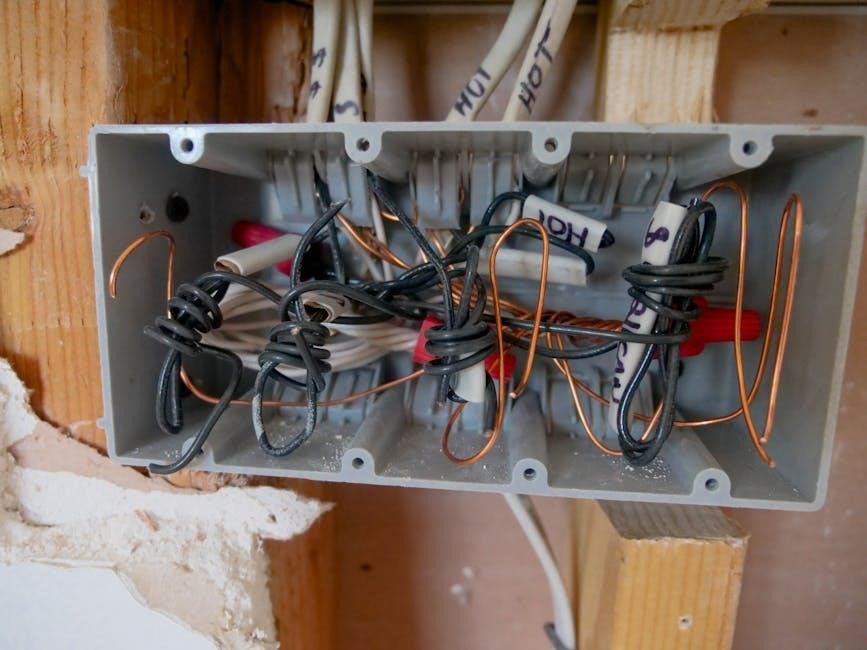
Start by turning off the power to your HVAC system at the circuit breaker to ensure safety. Remove the thermostat’s faceplate by either snapping it off or unscrewing it, depending on the model. Gently pull the thermostat away from the wall to access the wiring. Label each wire with tape to keep track of their connections. Use a screwdriver to disconnect the wires from the old thermostat’s terminals. Carefully remove the old thermostat from the wall, taking note of its position and any existing mounting hardware. Clean the area and prepare it for the new thermostat installation. Proper removal ensures a smooth transition to installing the Honeywell TH5220D1029.
3.3 Mounting the Honeywell TH5220D1029
Begin by peeling the backing from the adhesive on the mounting bracket and pressing it firmly onto the wall, ensuring it is level. If screws are preferred, drill pilot holes and secure the bracket. Align the Honeywell TH5220D1029 thermostat with the bracket, ensuring it clicks into place. Gently press the thermostat to confirm it is securely mounted. Make sure the display is facing the correct direction and the unit is level. If necessary, adjust the bracket slightly for proper alignment. Once mounted, double-check that the thermostat is stable and ready for wiring connection in the next step.
3.4 Connecting the Wiring
Connecting the wiring for the Honeywell TH5220D1029 requires careful attention to ensure proper functionality. Start by identifying the wires from your HVAC system, typically labeled as R (24V power), W (heating), Y (cooling), G (fan), and C (common). Match these wires to the corresponding terminals on the thermostat. If your system uses two-stage heating or cooling, connect the additional wires (W2/Y2) to their designated terminals. Ensure the C wire is properly connected if required by your system. Secure each wire firmly to prevent loose connections, which could cause malfunctions. After connecting, turn the power back on and verify the thermostat’s operation. If issues arise, double-check all connections for accuracy.
3.5 Finalizing the Installation
Once the wiring is connected, restore power to your HVAC system by switching the circuit breaker or fuse box. Turn the thermostat on and test its functionality by adjusting the temperature settings. Ensure the system responds correctly to heating and cooling demands. Check for any air leaks around the thermostat mount and ensure it is level for accurate temperature readings. Review the installation steps to confirm all connections are secure and correctly labeled. If any issues arise, refer to the troubleshooting section. Finally, dispose of packaging materials responsibly and store the installation manual for future reference. Your Honeywell TH5220D1029 is now ready for programming.
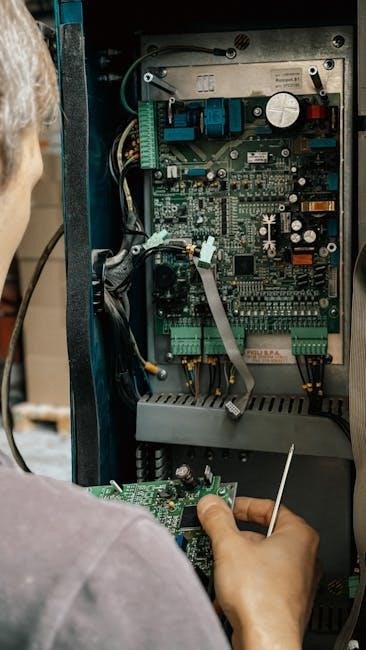
Programming the Thermostat
Program your Honeywell TH5220D1029 by setting temperature schedules and adjusting settings for energy efficiency. Follow on-screen prompts to customize your comfort preferences and optimize energy usage easily.
4.1 Setting Up the Initial Configuration
Start by turning on the thermostat and following the on-screen prompts. Select your system type (heat/cool) and configure temperature ranges. Set the date, time, and preferred temperature settings. Choose between manual or automatic operation and adjust the fan settings as needed. Ensure all settings align with your HVAC system’s capabilities. Use the touchscreen interface to navigate through options and confirm each selection. For remote setup, download the Honeywell Home app and link your thermostat. Once configured, test the system to ensure proper functionality. This initial setup ensures your thermostat operates efficiently and meets your comfort preferences. Proper configuration is essential for optimal performance and energy savings.
4.2 Creating a Temperature Schedule
Creating a temperature schedule with the Honeywell TH5220D1029 allows you to customize comfort and energy efficiency. Start by accessing the scheduling menu through the thermostat’s interface. Set specific temperatures for different times of the day, such as wake, leave, return, and sleep; Adjust the schedule to match your daily routine, ensuring optimal temperatures when needed. Use the touchscreen to input times and desired temperatures. For energy savings, lower temperatures when the house is empty or during sleep hours. The thermostat will automatically adjust, maintaining comfort while reducing energy use. Regularly review and update the schedule as needed to reflect changes in your lifestyle or preferences. This feature ensures consistent temperatures and helps lower utility bills year-round.
4.3 Utilizing Energy-Saving Features
The Honeywell TH5220D1029 offers advanced energy-saving features to optimize your HVAC system’s efficiency. Enable the Smart Recovery feature, which learns your system’s operation to pre-cool or pre-heat, reducing energy waste. Use the Energy Usage Report to track consumption and identify savings opportunities. Activate Geofencing to adjust temperatures based on your location, ensuring energy isn’t wasted when you’re away. Take advantage of Vacation Mode to maintain efficient temperatures during extended absences. Additionally, integrate the thermostat with smart home devices via the Honeywell Home app to enhance energy management. These features work together to minimize energy consumption while maintaining comfort, helping you save on utility bills without sacrificing convenience.
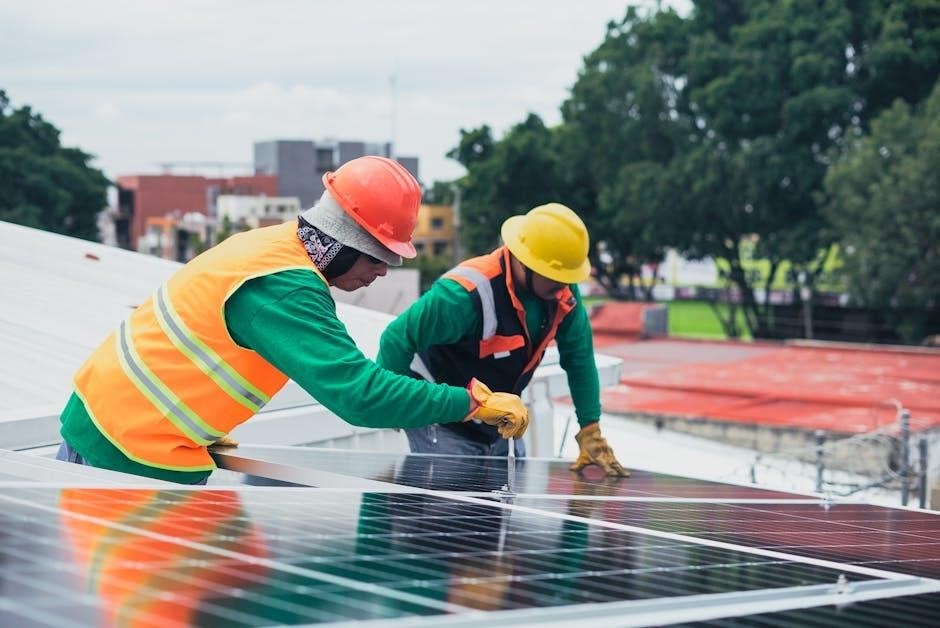
Post-Installation Checks
After installation, ensure the thermostat is powered on and displaying correctly. Test temperature adjustments to confirm system response. Verify HVAC operation and check for error messages.
5.1 Testing the Thermostat’s Functionality
After installation, verify the thermostat powers on and displays correctly. Adjust temperature settings to ensure the HVAC system responds appropriately. Check the accuracy of the temperature reading by comparing it with another thermometer. Test the scheduling feature by programming a simple schedule and observing if the temperature changes at the set times. Ensure the hold function works by overriding the schedule and maintaining a specific temperature. Check for any error messages and refer to the manual for troubleshooting. Test the responsiveness by adjusting the temperature and observing the system’s reaction time. Ensure all buttons and controls function properly. Check if the backlit display activates when buttons are pressed for visibility in low-light conditions. Test the smart response feature to see if the thermostat anticipates heating or cooling needs. Verify the ability to switch between heating and cooling modes in auto mode. Finally, reset the thermostat to factory settings and reprogram it to ensure no configuration issues were introduced during installation. By performing these tests, you can confirm the Honeywell TH5220D1029 thermostat is functioning correctly.
5.2 Ensuring Proper System Response
After testing the thermostat’s functionality, confirm the HVAC system responds correctly to temperature adjustments. Turn the system on in both heating and cooling modes to verify proper activation. Check for smooth transitions between modes and ensure the system does not operate simultaneously in heating and cooling. Verify the system’s response time aligns with the thermostat’s settings. If the system does not respond as expected, double-check wiring connections and ensure they match the thermostat’s configuration. Review the HVAC system’s compatibility with the thermostat to rule out any mismatches. If issues persist, consult the manual or contact Honeywell support for assistance. Proper system response ensures efficient and reliable operation.

Troubleshooting Common Issues
Troubleshooting the Honeywell TH5220D1029 involves identifying and resolving issues like display malfunctions, wiring problems, or system incompatibility. Always refer to the manual for specific guidance.
Common issues include error messages, unresponsive controls, or incorrect temperature readings. Check connections, restart the system, and ensure proper configuration to restore functionality and performance effectively.
6.1 Resolving Display Issues
Display issues with the Honeywell TH5220D1029, such as a blank or flickering screen, can often be resolved by restarting the thermostat. Ensure the device is properly powered and check for loose wiring connections. If the display remains unresponsive, verify that the thermostat is correctly mounted and configured. In some cases, incorrect installation or software glitches may cause display malfunctions. Refer to the manual for reset procedures or perform a factory reset if necessary. If problems persist, contact Honeywell customer support for assistance or consider consulting a professional technician to diagnose and repair the issue effectively. Always follow safety guidelines when handling electrical devices.
6.2 Addressing Heating or Cooling Malfunctions
If the heating or cooling system fails to respond to the Honeywell TH5220D1029 thermostat, check the temperature settings and ensure the schedule is correctly configured. Verify that the HVAC system switch is set to the appropriate mode (heat, cool, or auto). Loose wiring connections or incorrect wiring may cause malfunctions. Review the wiring diagram in the manual to ensure proper connections. If the issue persists, reset the thermostat or perform a factory reset. Additionally, check the HVAC system’s power source and air filters for blockages. If problems remain unresolved, consult a licensed HVAC technician or contact Honeywell support for further assistance.
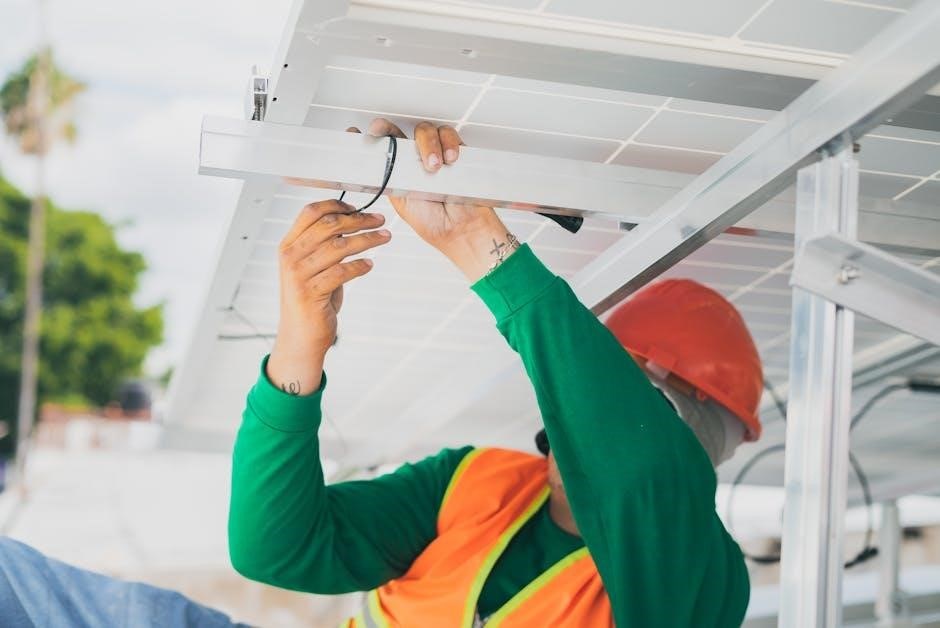
Maintenance and Care
Regularly clean the thermostat to prevent dust buildup and ensure accurate temperature readings. Replace batteries if applicable and check wiring connections for damage or wear.
- Clean the screen gently with a soft cloth.
- Inspect and replace air filters as needed.
- Ensure proper ventilation around the device.
7.1 Cleaning the Thermostat
Regular cleaning ensures optimal performance and longevity of the Honeywell TH5220D1029 thermostat. Power off the device before cleaning to avoid damage or electrical issues.
- Use a soft, dry cloth to wipe the exterior and screen.
- Dampen a cloth with mild detergent for stubborn stains, but avoid harsh chemicals.
- Never spray liquids directly on the thermostat, as this may damage internal components.
- Gently clean the buttons and edges to remove dust or debris.
- If accessible, inspect and clean internal vents or sensors to ensure accurate temperature readings.
Repeatedly cleaning maintains functionality and ensures precise temperature control.
7.2 Updating Software (if applicable)
Software updates ensure the Honeywell TH5220D1029 thermostat operates with the latest features and improvements. Check if your model supports firmware updates by visiting the Honeywell Home app or official website.
- Connect your thermostat to the Honeywell Home app to receive update notifications.
- Launch the app, navigate to the thermostat settings, and select “Update” if available.
- Download and install the update, ensuring the device remains powered on throughout the process.
- For non-smart models, updates may not be required, but regular maintenance like battery replacement is essential.
- Refer to the user manual or Honeywell support for specific update instructions or troubleshooting.
Updating ensures optimal performance and compatibility with your HVAC system.
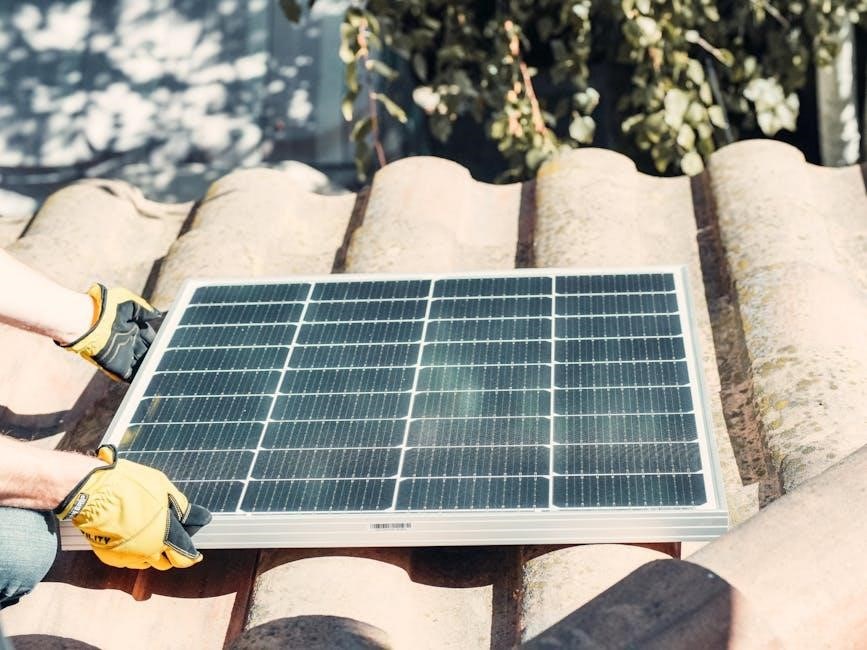
Advanced Features and Settings
The Honeywell TH5220D1029 offers advanced features like geofencing, smart recovery, and custom temperature curves to enhance comfort and efficiency. These settings optimize HVAC performance seamlessly.
8.1 Smart Home Integration
The Honeywell TH5220D1029 seamlessly integrates with popular smart home systems like Amazon Alexa and Google Home, enabling voice control and enhanced automation. Using the Honeywell Home app, users can remotely monitor and adjust temperatures, receive alerts, and optimize energy usage. Geofencing technology allows the thermostat to sense your location, automatically adjusting settings for efficiency. Compatibility with Zigbee and Z-Wave hubs expands its connectivity to other smart devices. This integration ensures a unified smart home experience, offering convenience, energy savings, and personalized comfort tailored to your lifestyle and preferences.
8.2 Using the Honeywell Home App
The Honeywell Home app serves as the central control hub for your TH5220D1029 thermostat, offering remote access and advanced features. Users can download the app on iOS or Android devices, create an account, and connect it to their thermostat. With the app, you can adjust temperatures, view energy usage, and set custom schedules. It also allows for geofencing, enabling the thermostat to adjust settings based on your location. The app provides alerts for system issues, helping you maintain optimal performance. By leveraging these features, you can enhance comfort, reduce energy waste, and enjoy seamless control over your HVAC system from anywhere.
8.3 Adjusting Advanced Temperature Controls
The Honeywell TH5220D1029 allows users to fine-tune temperature settings for optimal comfort and efficiency. Advanced temperature controls include features like temperature hold, which overrides the schedule for manual adjustments, and smart recovery, which learns how long it takes to reach the desired temperature. Users can also set temperature limits to prevent extreme highs or lows. These controls can be accessed via the thermostat’s interface or the Honeywell Home app. Adjusting these settings ensures the system operates efficiently while maintaining a consistent indoor climate. Proper use of these features can lead to energy savings and enhanced system performance over time.

Manufacturer Support and Resources
Honeywell offers comprehensive support for the TH5220D1029, including online resources, troubleshooting guides, and dedicated customer service to assist with installation and operation.
9.1 Contacting Honeywell Customer Service
To contact Honeywell customer service for assistance with the TH5220D1029 installation, visit their official website or call their dedicated support line. Live chat and email options are also available for troubleshooting and installation guidance. Ensure to have your model number ready for faster assistance. Honeywell’s customer service operates Monday through Friday, 8 AM to 6 PM EST. For urgent issues, phone support is recommended for immediate resolution. Their team is trained to address installation-related queries and provide detailed step-by-step solutions. Additionally, the Honeywell Home app offers in-app support features for convenient access to help resources. Always verify contact information through Honeywell’s official website to ensure accuracy.
9.2 Accessing Online Manuals and Guides
To access the Honeywell TH5220D1029 installation manual and other guides, visit Honeywell’s official website. Navigate to the “Support” section, where you can search for your specific model. Download the PDF manual directly from the site, ensuring you have the most up-to-date version. Additional resources, such as installation videos and FAQs, are also available to assist with setup. For convenience, Honeywell often provides digital versions of their manuals, which can be accessed 24/7. Always verify the website’s authenticity to avoid unofficial sources. The Honeywell Home app may also offer access to digital manuals and guides, streamlining the installation process. These resources ensure proper installation and troubleshooting for optimal performance.
